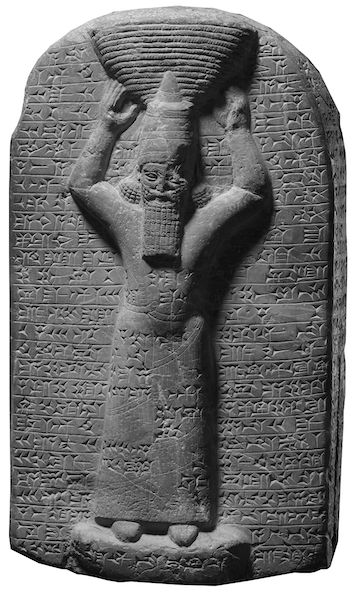Ashurbanipal (r. 668–ca. 631 BC)

BM 090864, a marble stele depicting Ashurbanipal carrying a basket on his head and recording that king's restoration of Ekarzagina, the temple of the god Ea in the Esagil complex. Image adapted from the British Museum Collection website. Credit: Trustees of the British Museum.
Despite the fact that Šamaš-šuma-ukīn (r. 667–648 BC) and Kandalānu (r. 647–627 BC) were the kings of Babylon, Ashurbanipal — Esarhaddon's fourth eldest-son and immediate successor as the king of Assyria — sponsored construction in at least ten Babylonian cities, as well as in the East Tigris region. Some of the projects, especially those at Babylon (the capital city of his older brother Šamaš-šuma-ukīn), were initiated by his father (before his death in late 669 BC) and merely completed by him, while a few were started and finished by Ashurbanipal himself. From presently-known texts, mostly royal inscriptions, this seventh-century-BC Assyrian king is known to have worked on the following buildings in Babylonia:
- Agade
- Eulmaš (temple of the goddess Ištar)
- Babylon
- Duku ("Dais of Destinies ," seat of the god Marduk as Lugaldimmeranki in Ubšukkina in Esagil)
- Ekarzagina (temple of the god Ea in the Esagil temple complex)
- Emah (temple of the goddess Bēlet-ilī)
- Esabad (temple of the goddess Gula)
- Esagil (temple of the god Marduk)
- Esiskur (New Year's temple of the god Marduk)
- Etemenanki (ziggurat of the god Marduk)
- Eturkalama (temple of the goddess Ištar as Bēlet-Bābili in the Esagil temple complex)
- Eumuša (cella of the god Marduk)
- Imgur-Enlil and Nēmetti-Enlil (the inner city walls)
- Kahilisu (gate of Edara'ana, the cella of the goddess Zarpanitu)
- Borsippa
- Emešara (a shrine)
- Ezida (temple of the god Nabû)
-
- Ka-Lamma-RA.BI (gate of Ezida)
-
- Kaluguduene (gate of Ezida)
-
- Kanamtila (gate of Ezida)
-
- Kamah (gate of Ezida)
-
- Ka-Utu-e(a) (Akkadian bāb ṣit šamši; gate of Ezida)
- Kizalaga (shrine of the god Nūru)
- Ṭābi-supūršu (city wall)
- Dūr-Kurigalzu
- ziggurat of the god Enlil
- Cutha
- Emeslam (temple of the god Nergal)
- Mê-Turān
- Ešahula (temple of the god Nergal)
- Nippur
- Egigunû (ziggurat temple of the god Enlil)
- Ehursaggalama (ziggurat of the god Enlil)
- Ekur (temple of the god Enlil)
- Sippar
- Ebabbar (temple of the god Šamaš)
- Uruk
- Eanna (temple of the goddess Ištar)
- Ehiliana (cella of the goddess Nanāya in Eanna)
It is possible that Ashurbanipal might have also worked on the following: Ehursagtila (temple at the god Ninurta) and Erabriri (temple of the god Madānu) at Babylon; Nippur's city wall; Sippar's city wall Badullisâ; and Ehiliana (shrine of the goddess Nanāya in Eanna) at Uruk. This cannot be confirmed with certainty given the lack of presently-available contemporary textual evidence.
Furthermore, at Ur, the most important cult center of the moon-god in Babylonia, Sîn-balāssu-iqbi, a governor of that city loyal to Assyria, undertook construction on Sîn's temple Ekišnugal on behalf of Ashurbanipal. That important official, as far as his inscriptions are preserved, rebuilt and restored the following at Ur: Eadgigi, the abode of the god Nusku; Eankikuga, the station of the god Kusu; Eanšar, a "royal abode"; É.AŠ.AN.MAR (exact reading uncertain), the abode of the god Enlil; Eešbanda, the abode of the goddess Šuzianna; É.DUB.galekura (exact reading uncertain), the abode of the god Ninimma; Elugalgalgasisa, the ziggurat; Ešaduga, the "abode of Enlilship"; Etemennigurru, the ziggurat terrace; Eušumgalana, the station of the goddess Ninkasi; É...gukuga (name not fully preserved), an abode or seat of the god Ennugi; Gipāru, a sanctuary of the goddess Ningal; and Puuilituma, a well located in the temple complex.
Ashurbanipal also carried out construction in the East Tigris region, at Dēr, where he rebuilt Edimgalkalama, the temple of the god Anu rabû (Ištarān). As is clear from numerous inscriptions, he invested a great deal of time and effort working on the principal religious structures at Harran — a large garrison and important trading center situated on the route between the Mediterranean Sea and the plains of the middle Tigris — where he rebuilt and enlarged Ehulhul (temple of the god Sîn), rebuilt the New Year's festival house (akītu-temple), and constructed a new temple for the god Nusku (Emelamana). The most important rooms of all three of these buildings, including the cella of the goddess Nikkal (Egigar), were lavishly decorated with metal(-plated) objects. Rebuilding Ehulhul was one of the most important building projects initiated and completed by Ashurbanipal.
Jamie Novotny & Niclas Dannehl
Jamie Novotny & Niclas Dannehl, 'Ashurbanipal (r. 668–ca. 631 BC)', Babylonian Temples and Monumental Architecture online (BTMAo), The BTMAo Project, a sub-project of MOCCI, [http://oracc.org/btmao/StructuresbyBuilder/Neo-AssyrianPeriod/Ashurbanipal/]